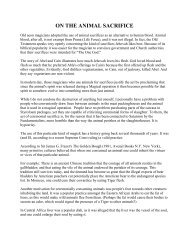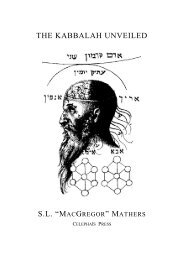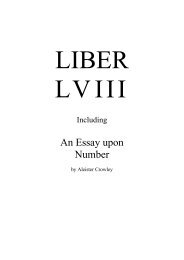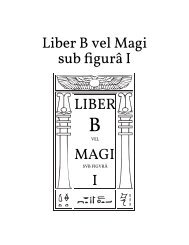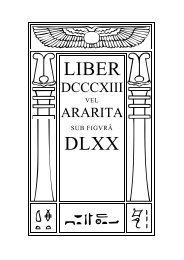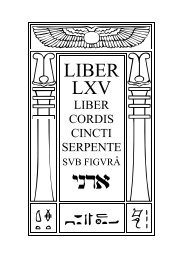Annotated Ritual of the Eucharist
Annotated Ritual of the Eucharist
Annotated Ritual of the Eucharist
Create successful ePaper yourself
Turn your PDF publications into a flip-book with our unique Google optimized e-Paper software.
descends, and with <strong>the</strong> children following her, <strong>the</strong> positive next her,<br />
she moves in a serpentine manner involving 3 circles <strong>of</strong> <strong>the</strong> Temple.<br />
(Deosil about altar, widdershins about font, deosil about altar and<br />
font, widdershins about altar, and so to <strong>the</strong> Tomb in <strong>the</strong> West.) 28<br />
She draws her Sword and pulls down <strong>the</strong> Veil <strong>the</strong>rewith. 29<br />
The PRIESTESS: By <strong>the</strong> power <strong>of</strong> 30 Iron, I say unto <strong>the</strong>e, Arise. In <strong>the</strong> name <strong>of</strong> our Lord<br />
<strong>the</strong> Sun, and <strong>of</strong> our Lord ... 31 that thou mayst administer <strong>the</strong> virtues to <strong>the</strong><br />
Brethren.<br />
She shea<strong>the</strong>s <strong>the</strong> Sword.<br />
The PRIEST, issuing from <strong>the</strong> Tomb, holding <strong>the</strong> Lance erect with both<br />
hands, right over left, against his breast, takes <strong>the</strong> first three regular<br />
steps. 32<br />
He <strong>the</strong>n gives <strong>the</strong> Lance to <strong>the</strong> PRIESTESS, and gives <strong>the</strong> three penal<br />
signs. 33<br />
He <strong>the</strong>n kneels and worships <strong>the</strong> Lance with both hands. 34<br />
<strong>the</strong> physical gesture <strong>of</strong> <strong>the</strong> kiss. Freemason Albert Mackey notes that “<strong>the</strong> most primitive act <strong>of</strong> adoration was<br />
by <strong>the</strong> application <strong>of</strong> <strong>the</strong> fingers to <strong>the</strong> mouth.” This kissing <strong>of</strong> <strong>the</strong> fingers or hand(s) towards <strong>the</strong> object adored<br />
is an appropriate way to fulfill <strong>the</strong> instruction to “adore” in Liber XV when fur<strong>the</strong>r specifics are not provided.<br />
28 The Deacon does not participate in this procession, and at its beginning he or she should move deosil<br />
around <strong>the</strong> altar <strong>of</strong> incense to take up a position in <strong>the</strong> nor<strong>the</strong>ast at <strong>the</strong> foot <strong>of</strong> <strong>the</strong> dais (in anticipation <strong>of</strong><br />
bringing <strong>the</strong> robe and crown). At <strong>the</strong> conclusion <strong>of</strong> <strong>the</strong> serpentine circumambulations <strong>of</strong> <strong>the</strong> Priestess, <strong>the</strong><br />
children should deploy into <strong>the</strong> outer corners <strong>of</strong> <strong>the</strong> western triangle <strong>of</strong> <strong>the</strong> temple ground. They are thus<br />
balanced opposite one ano<strong>the</strong>r, and available to serve <strong>the</strong> Priestess. In this instance, as in all cases where <strong>the</strong><br />
children occupy static positions, <strong>the</strong> positive child should be in <strong>the</strong> south, and <strong>the</strong> negative in <strong>the</strong> north.<br />
29 “Pulls down <strong>the</strong> veil”: a sliding curtain is not recommended. Tomb designers may wish to consider <strong>the</strong><br />
virtues <strong>of</strong> velcro. The Priest’s eyes should be shut, and he should be holding <strong>the</strong> Lance vertically against his<br />
breast, right hand over left. He will open his eyes in response to <strong>the</strong> words <strong>of</strong> <strong>the</strong> Priestess. In order to leave<br />
room for <strong>the</strong> three regular steps, it may be necessary for him to begin deep in <strong>the</strong> tomb, or for her to take a<br />
step backward as she shea<strong>the</strong>s her sword.<br />
30 The ability and willingness to hallucinate as a ritual <strong>of</strong>ficer in sacramental work is <strong>of</strong> great importance, and<br />
<strong>the</strong> crosses drawn in <strong>the</strong> Mass should be just as vividly perceptible as <strong>the</strong> pentagrams in a banishing ceremony.<br />
“According to Agapé Lodge tradition, <strong>the</strong> Priestess makes <strong>the</strong> sign <strong>of</strong> <strong>the</strong> cross with her sword, held point up.”<br />
–Helena & T Apiryon<br />
31 In a private Mass, <strong>the</strong> Priestess may fill this ellipsis, according to her initiated ingenium and with <strong>the</strong> counsel<br />
<strong>of</strong> her supervising Bishop. In public Masses, she should pause briefly to indicate <strong>the</strong> omission.<br />
32 To make <strong>the</strong>se regular steps at a public Mass, stand with <strong>the</strong> feet square as for <strong>the</strong> step <strong>of</strong> a Man and a<br />
Bro<strong>the</strong>r (see note 21, above). Advance <strong>the</strong> left foot, and <strong>the</strong>n bring <strong>the</strong> right heel into its hollow. Repeat this<br />
step twice more. These steps were used in O.T.O. initiation when <strong>the</strong> Mass was first composed. At private<br />
Mass, <strong>the</strong> corresponding M∴M∴M∴ steps may be used.<br />
33 The first penal sign is <strong>the</strong> Sign <strong>of</strong> a Man and a Bro<strong>the</strong>r, as described in note 21. The second is similar, but <strong>the</strong><br />
right hand begins at <strong>the</strong> heart. The third sign cuts across <strong>the</strong> midsection, and returns to <strong>the</strong> navel. As with <strong>the</strong><br />
o<strong>the</strong>r signs, <strong>the</strong>se are obsolete degree material, and <strong>the</strong>y may be replaced with <strong>the</strong> current M∴M∴M∴ signs at<br />
private Mass.<br />
34 One reading <strong>of</strong> this cryptic use <strong>of</strong> <strong>the</strong> verb “to worship” is as follows: present <strong>the</strong> open palms, fingers<br />
upward, towards <strong>the</strong> Lance, as if basking in its radiance.<br />
Liber XV with Practical Annotations by T Polyphilus, Ep. Gn. 7



